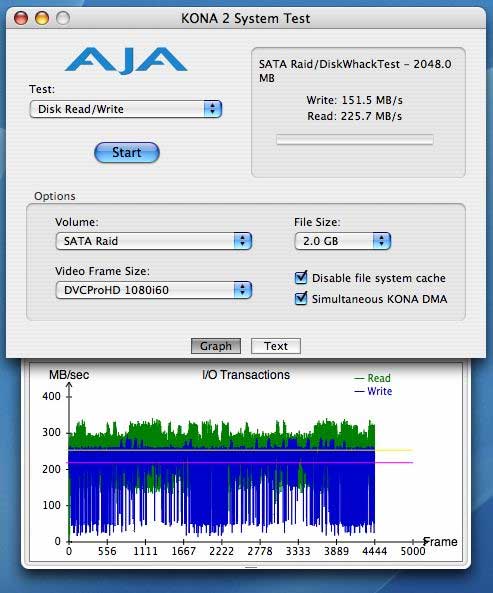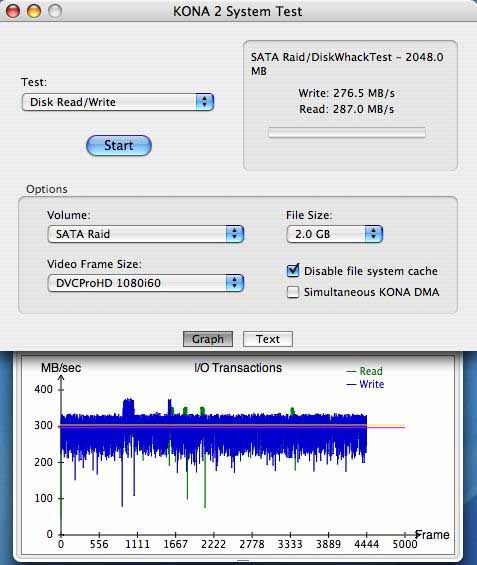Let's welcome the arrival of the SATA
raid!
For under $1000, I was able to roll my
own 1 TB SATA raid with only a little frustration and a little
humiliation to show for it. This was to be a quick process of
assembling the MacGurus 4-drive
Burly Box with 4 Hitachi 250 gig SATA drives and using the
Sonnet
Tempo-X 4+4 SATA card to control the drives. So, I put together
a volunteer crew to do a 2-camera shoot to post on the web site.
Four hours and many tapes later, I got it together. I have since
swapped the Tempo 4+4 card for the Tempo-X
eSata 8 card, with 8 external connections.
The Burly Box is a wonderful metal enclosure
with a heavy-duty fan, heavy-duty power supply and a sturdy feel.
MacGurus bundles mounting brackets for the drives as well as
all necessary cables both for creating the enclosure and connecting
to the Mac. The problem arose with my general inability to assemble
anything. I find now that if I merely had a magnetized screw
driver and had used some petroleum jelly or soap on the screws,
the multi-hour multi-cursed enterprise of screwing the brackets
into the drives would have taken no time at all. So, let's assume
that the typical do-it-yourselfer is smarter than I am when it
comes to assembly. The Burly Box is then a snap to assemble.
Start running the tab: $254 plus $11 shipping for the 4-enclosure
BurlyBox. MacGurus also supplies 2, 5 or 8 drive enclosures.
Additionally, there are hot-swap enclosures but they will not
do you much good with the Sonnet as of yet since the Sonnet does
not yet support hot swapping. Sonnet engineers are looking into
this and plan to deliver a firmware upgrade which will allow
hotswapping.
Newsflash-On April 13, 2005, Sonnet released
version 1.1 of the Tempo-X firmware which updates both the SATA
4+4 and the eSata 8 cards to include hot swapping drives!
Now, back to the construction of the
boxes.
Along with the introduction of the Tempo-X
eSata 8 card, I added another identical Burly Box and four more
Hitachi drives. Installation was somewhat smoother this time
since my purchase of the screwdriver magnetizer.
In fact, getting the screws in the holes was a snap. The only
problem was identification of the screws and it is in this area
that the Burly Box packaging needs improvement. Assembly requires
drive screws to attach the brackets and bracket screws to mount
the drive/bracket assembly in the box. The two types of screws
are mingled in the hardware bags. It would be very simple, I
think, just to include one bag of drive screws and one bag of
bracket screws.
In constructing the second box, my only
gaffes consisted of destroying one 250 gig drive by breaking
off the SATA data connector on the drive and then in the assembly
of the unit, breaking one of the drive to external port connectors.
The first problem was solved by begging the vendor to swap the
drive (they did) and the broken connector was solved merely by
connecting the Burly Box to eSata 8 cable internally in the Burly
Box directly to the drive and then running out of the box directly
to the card. Not very elegant, I note, but I did work.
 I
chose to use the Sonnet Tempo 4+4 card to control my raid since
that was what was available in early February when I built the
first raid, and it receives a Circle N seal of approval. Unlike
other products on the market, the Sonnet requires no drivers.
It is true plug and play. You can also configure the Mac with
multiple Sonnet cards. The 4+4 card ($199) has 4 external and
4 internal ports. My Burly Box is connected, of course, to the
4 external ports. Each drive occupies a separate channel, so
there are 4 external SATA cables between card and box. It is
possible to add 4 internal drives to the card using any of the
internal products for G5 (such as ProMax solution, Wiebetech
or Transinternational products). Personally, I think that is
too much heat for the G5, but others have not reported problems.
The other option is to use a slot on the Mac and add the $25
internal to external connector from MacGurus. That would allow
8 drives.
I
chose to use the Sonnet Tempo 4+4 card to control my raid since
that was what was available in early February when I built the
first raid, and it receives a Circle N seal of approval. Unlike
other products on the market, the Sonnet requires no drivers.
It is true plug and play. You can also configure the Mac with
multiple Sonnet cards. The 4+4 card ($199) has 4 external and
4 internal ports. My Burly Box is connected, of course, to the
4 external ports. Each drive occupies a separate channel, so
there are 4 external SATA cables between card and box. It is
possible to add 4 internal drives to the card using any of the
internal products for G5 (such as ProMax solution, Wiebetech
or Transinternational products). Personally, I think that is
too much heat for the G5, but others have not reported problems.
The other option is to use a slot on the Mac and add the $25
internal to external connector from MacGurus. That would allow
8 drives.
 I
now have installed the Tempo-X eSata 8 card. If there is such
a thing as a 2-N seal of approval, this card gets it. It is hard
to imagine running eight external drives from one card occupying
one slot.
I
now have installed the Tempo-X eSata 8 card. If there is such
a thing as a 2-N seal of approval, this card gets it. It is hard
to imagine running eight external drives from one card occupying
one slot.
My test G5 system now includes a Kona 2 board
occupying the PCI 133 slot and the Sonnet Tempo-X eSata8 card
in Slot 3. Note something about the eSata8 card. It requires
different external connectors, called eSata connectors. They
are only available from one manufacturer at the moment, so they
are a few dollars more per cable than external SATA cables. Both
Sonnet and MacGurus sell the eSata cables and, since the release
of the eSata8 card, MacGurus offers the BurlyBox with an option
of cables. Sonnet maintains that the eSata cables provide a more
reliable connection and are rated at a greater number of insertions
than standards SATA cables.
Also note that the eSata8 has a slightly
raised daughter card to handle the extra ports. It cannot be
used in Slot 4 (the PCI-X 133) slot of the G5. That makes little
difference, in my opinion, since most likely you would want to
put a capture card in the 133 mhz slot.
Creating the raid with Apple Disk Utility
is as simple as just clicking raid and dragging the 4 drives
into the raid window.
Below are benchmarks for this 4 drive
raid using AJA's Test Utility and the eSata8 card. The Tempo
4x4 card returned similar results. My own tests have given me
6 layers of realtime in DVCPRO HD 720p from footage captured
from the Varicam as well as the ability to playback 8-bit 1080i
HD. Granted this is from footage which was supplied to me and
not captured on this system form HDCAM deck. It also was tested
on a relatively empty drive. I would not recommend 8-bit uncompressed
HD on this configuration. Based upon these benchmarks for a 4-drive
raid, I do believe that an 8-drive raid would handle HDCAM.

Now, note the same benchmarks for the
Tempo-X eSata 8 running two Burly Boxes, each containing 4 Hitachi
250 SATA drives. By the way, these drives in RAID configuration
format to 1.8 TB.

The difference between a four drive and
an either drive RAID is apparent. The data rate which exceeds
200 mps with 8 drives makes this array able to handle 8-bit and
quite possibly 10-bit HDCAM.
The downside here is something to note
very strongly. We are talking raid 0 configurations. There
is no parity as in raid 5 meaning that losing one drive takes
with it all of the data. When dealing with a higher end raid
with a dedicated controller, that raid controller allows a hardware-based
raid 5 as well as hardware-based integrity checks on the media.
Sometimes the least expensive solution is not the best. So, I
offer this solution of the inexpensive roll it yourself raid
as an example of where the technology is taking us.
In addition, I suspect that performance
will decrease as the drives fills up. As a result, I would avoid
filling the drive to more than 66.33% capacity, the amount recommended
by SoftRaid as constituting
the largest suggested video partition.
The absence of parity requires careful
backup procedues. While it is sound FCP procedure anyway, make
certain not to store project files on the media drive. Store
those on your system drive (and back them up, of course). With
regard to the raid, back up any graphics, music, or other files
which have been created on the drive. In that manner, the worst
case scenario in the event of losing the RAID is just to restore
the files and recapture from original tapes.
Both Sonnet cards can be used to control
individual drives or drives configured as a raid. They are solid
worthy performers and can form the basis of this inexpensive
raid for both the capacity and the speed that raid storage provides
us. At $299, the eSata8 is $100 more than the Tempo 4+4. It is
worth the difference if you wish to create an 8-drive raid and
still use only one slot. And the whole exercise led me to my
nearest home improvement warehouse to buy a screwdriver magnetizer.
Even if I break connectors, I still get the screw in the hole.
In terms of practical tests, I have been
able to edit 1920x1080 8-bit HDCAM on this raid without dropping
a frame. It integrates well with the Kona 2 card currently in
my machine, courtesy of my good friends at AJA. And very special
thanks to Martin Muggee and others at Sonnet for the use
of these two excellent cards.
Bottom line price:
Sonnet Tempo-X eSata 8 $299
8 Hitachi 250 SAYA drives $1080
2 Burly Boxes $508
Extra for SATA 8 eSata cables $120
Shipping $ 11
Total cost of 1.8 TB formatted $2018
The SATA raid is here to stay and promises
to be a strong competitor to SCSI. All of the products mentioned
here receive the Ned Seal of Approval and are worthy additions
to your edit station.
Ned Soltz
copyright©2005ned
soltz
Ned
Soltz is a passionate advocate of technology which enhances
the creative process. He only wishes that he were more creative.
Ned is among the founders of lafcpug, as well as a published
author of numerous articles and reviews on all things NLE. The
author of several books and technical editor of still others,
Ned is often on the road with his Powerbook G4 and mobile FCP
studio. Catch him at home or on the road at nsoltz@aol.com
Ned also moderates several forums on 2-pop.com